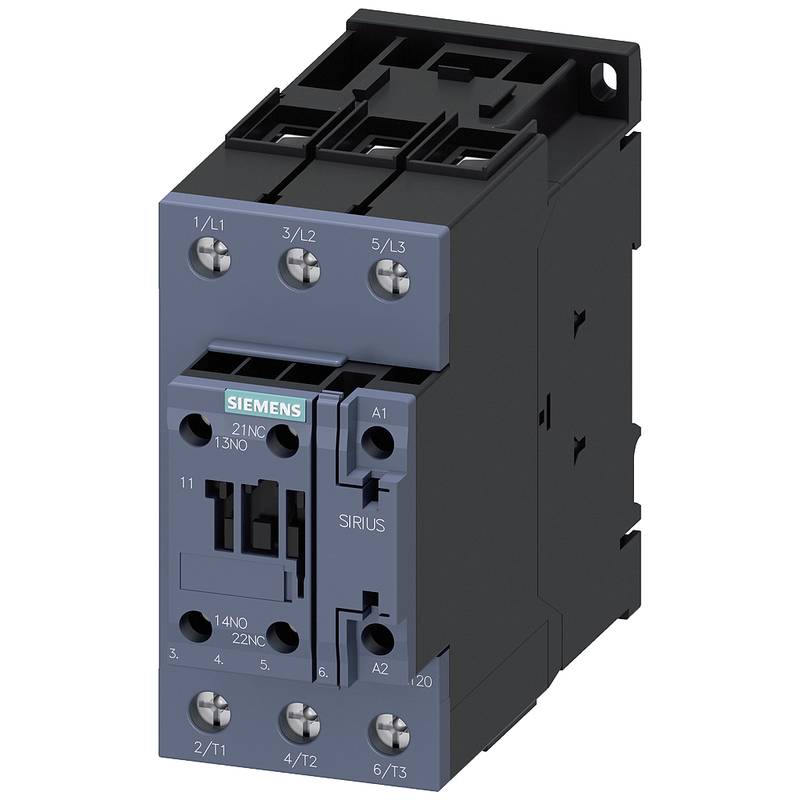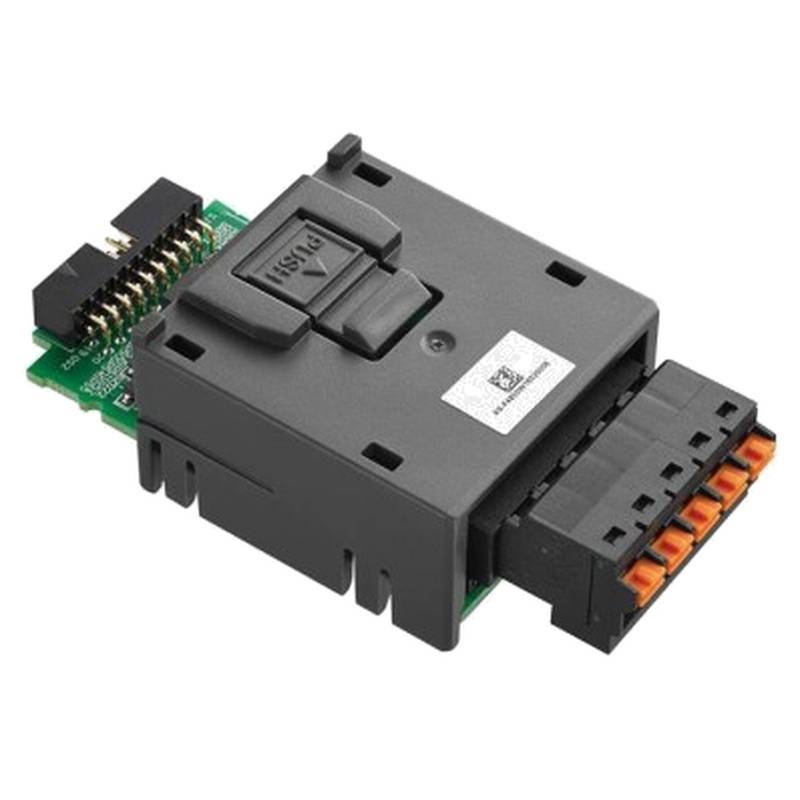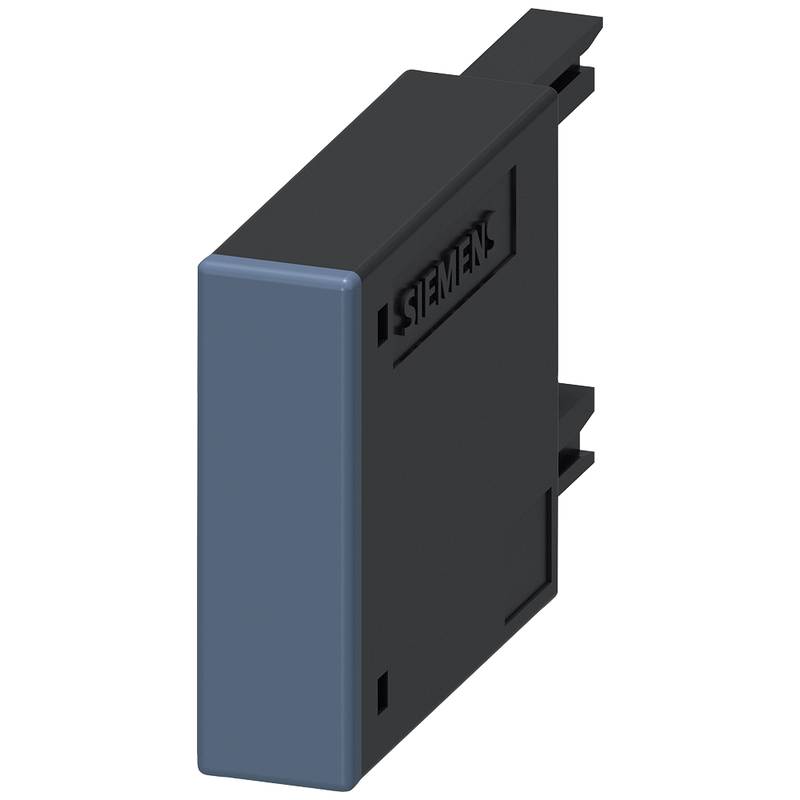
The Siemens 3RT2036-1AK60 SIRIUS heavy-duty industrial contactor is engineered for demanding applications, offering robust performance and reliability. With a 110VAC coil voltage and a 50A power rating, this 3NO (three normally open) contactor is a cornerstone component for industrial automation and power control systems. Its key advantages lie in its compact design, superior switching capacity, and seamless integration within the broader SIRIUS modular system. The 3RT2036-1AK60 excels in motor control, power distribution, and load switching across various industrial sectors.
Product Specifications
| Feature | Specification |
| :------------------- | :------------------------------------------- |
| Product Type | Contactor |
| Series | SIRIUS 3RT2 |
| Manufacturer | Siemens |
| Model Number | 3RT2036-1AK60 |
| Coil Voltage | 110 VAC |
| Rated Operational Current (AC-1, 400V) | 50 A |
| Number of Poles | 3 |
| Number of Normally Open (NO) Contacts | 3 |
| Auxiliary Contacts | 1 NO + 1 NC (integrated) |
| Mounting Type | DIN rail or screw mounting |
| Terminal Type | Spring-loaded terminals |
| Protection Class | IP20 |
| Ambient Temperature | -25 to +60 °C |
| Standards | IEC/EN 60947-4-1, VDE 0660, UL, CSA |
Core Features & Market Positioning
The Siemens 3RT2036-1AK60 distinguishes itself through its advanced Latching technology and exceptional thermal stability, ensuring consistent performance even under high ambient temperatures. Its market positioning is firmly rooted in its reputation for Siemens' unparalleled quality and durability, making it a preferred choice for critical infrastructure and high-cycle applications where downtime is not an option. The integration capabilities with other SIRIUS devices, such as overload relays and communication modules, further enhance its value proposition, allowing for sophisticated and adaptable control solutions. This 50A industrial contactor is designed for longevity and efficient power management.
Key Application Scenarios
This Siemens 3RT2036-1AK60 contactor finds extensive use in direct-on-line (DOL) motor starting, reversing motor applications, and as a main switching device in power distribution panels. Industries such as manufacturing, material handling, HVAC systems, and water treatment plants frequently deploy this robust 110VAC controlled device for reliable load switching. Its suitability for controlling pumps, fans, compressors, and conveyor systems underscores its versatility in a wide array of industrial automation tasks. The 3NO configuration is ideal for direct motor control circuits.
Practical System Integration Guidance
Integrating the Siemens 3RT2036-1AK60 into existing control systems is straightforward due to its standardized mounting and connection options. For motor control, it is typically wired in series with the motor windings, with the control circuit connected to the 110VAC coil. It is crucial to ensure proper wiring of the power terminals and the auxiliary contacts, which can be used for control feedback or interlocking. Compatibility with SIRIUS overload relays (e.g., 3RU21 or 3RB3) is essential for effective motor protection, with the relay often mounted directly below the contactor.
Operation and Risk Mitigation
Safe operation of the Siemens 3RT2036-1AK60 hinges on adhering to electrical safety standards and proper installation practices. Always ensure the power supply is de-energized before performing any wiring or maintenance. The spring-loaded terminals provide secure connections, reducing the risk of loose wiring. Overload protection, managed by a properly sized and configured overload relay, is critical to prevent motor damage and potential fire hazards. For troubleshooting, checking the coil voltage and ensuring the control circuit is functional are primary steps.
Scalability & Long-Term Value
The Siemens 3RT2036-1AK60 is part of the expansive SIRIUS innovation ecosystem, offering significant scalability and long-term value. Its compatibility with various communication interfaces and digital solutions allows for seamless integration into Industry 4.0 environments and IIoT platforms. This facilitates remote monitoring, diagnostics, and predictive maintenance. Upgrading or expanding control systems built around this contactor is simplified due to the modular design of the SIRIUS line, ensuring that investments in robust Siemens components continue to provide value for years to come.
FAQs
Q1: What is the primary function of the Siemens 3RT2036-1AK60?
The Siemens 3RT2036-1AK60 is a heavy-duty industrial contactor designed for switching electrical loads. It is commonly used to control motors, power distribution circuits, and other high-power applications in industrial settings. Its robust construction ensures reliable operation under demanding conditions.
This 50A, 3-pole device utilizes a 110VAC coil to actuate its switching mechanism. The three normally open (NO) contacts are ideal for directly controlling motor windings in applications like direct-on-line starting.
Its integration into the SIRIUS modular system allows for easy combination with other components like overload relays for comprehensive motor protection.
Q2: What are the key technical specifications for this contactor?
This Siemens contactor, model 3RT2036-1AK60, features a 110VAC coil voltage for control. It boasts a rated operational current of 50A for AC-1 duty at 400V.
The contactor has three main poles, all configured as normally open (NO) contacts. It also includes integrated auxiliary contacts, typically 1 NO and 1 NC, for control and signaling purposes.
Mounting is flexible, supporting DIN rail or screw mounting, with spring-loaded terminals for secure connections. It operates within an ambient temperature range of -25 to +60 °C.
Q3: In which industrial applications is the 3RT2036-1AK60 typically used?
The 3RT2036-1AK60 is frequently applied in direct-on-line (DOL) motor starting circuits for various industrial machinery. It serves as a main switching device in control panels for pumps, fans, compressors, and conveyor systems.
Its robust design makes it suitable for environments requiring high reliability, such as manufacturing plants, water treatment facilities, and HVAC systems. The 50A rating handles substantial power loads effectively.
The contactor's ability to switch high currents makes it a vital component for load shedding and power distribution within complex industrial power systems.
Q4: How does the 110VAC coil voltage affect its operation?
The 110VAC coil voltage dictates the control power required to energize the electromagnet within the contactor. This voltage is common in many industrial control systems, simplifying integration.
When 110VAC is applied to the coil, it creates a magnetic field that pulls the armature, closing the main power contacts and allowing current to flow to the load. When the voltage is removed, a spring returns the armature, opening the contacts.
Selecting the correct coil voltage is crucial for safe and efficient operation; using the wrong voltage can lead to malfunction or damage to the contactor or control circuit.
Q5: What is the significance of the "3NO" contact configuration?
"3NO" signifies that the Siemens 3RT2036-1AK60 has three main power poles, and each pole is configured as a normally open (NO) contact. This means that in its de-energized state, all three contacts are open, preventing current flow.
When the 110VAC coil is energized, all three of these normally open contacts close simultaneously. This action allows power to pass through to the connected load, such as a three-phase motor.
This configuration is standard for directly switching the power supply to three-phase loads where the motor needs to be connected directly to the power source upon activation.
Q6: How do I properly install and wire the Siemens 3RT2036-1AK60?
Installation involves mounting the contactor securely on a DIN rail or via screw fixings in a control cabinet. Ensure adequate ventilation around the unit to prevent overheating.
Wiring requires connecting the power source (line and load) to the main terminals, observing correct phase rotation for three-phase loads. The 110VAC coil is wired to the A1 and A2 terminals, connected to the control circuit.
Always verify the coil voltage and ensure the control circuit is isolated before commencing wiring. Consult the product manual for specific terminal designations and recommended wiring diagrams.
Q7: What is the role of auxiliary contacts on this contactor?
The Siemens 3RT2036-1AK60 typically comes with integrated auxiliary contacts, often 1 normally open (NO) and 1 normally closed (NC). These contacts are electrically separate from the main power contacts.
The NC auxiliary contact can be used in series with the contactor's coil to create a holding or latching circuit, preventing re-energization under certain conditions. It is also vital for interlocking between multiple contactors.
The NO auxiliary contact can provide feedback to a PLC or control system, indicating that the main contacts are closed and the load is energized, or it can be used to activate signaling devices.
Q8: What overload protection is recommended for use with this contactor?
Overload protection is essential and is typically achieved using a separate overload relay, such as Siemens' 3RU21 or 3RB3 series. These relays are designed to be mounted directly onto the 3RT2036-1AK60 contactor.
The overload relay monitors the current drawn by the motor. If the current exceeds a preset limit for a specific duration, it trips, opening a control circuit contact that de-energizes the contactor's coil, thus stopping the motor and preventing damage.
Proper selection and setting of the overload relay's current rating, based on the motor's full load amperage (FLA), are critical for effective motor protection and preventing nuisance tripping.
Q9: Can this contactor be integrated into an IIoT or Industry 4.0 system?
Yes, the Siemens 3RT2036-1AK60 can be integrated into IIoT and Industry 4.0 systems. This is typically achieved by incorporating communication modules or gateways within the control panel.
These modules interface with the contactor's auxiliary contacts or directly with intelligent motor control devices. This allows for remote monitoring of status (energized/de-energized), diagnostics, and data logging.
By connecting to a central control system or cloud platform, the contactor's operational data can be analyzed for predictive maintenance, performance optimization, and enhanced system control.
Q10: What are common troubleshooting steps for a Siemens 3RT2036-1AK60?
First, verify that the 110VAC control voltage is present at the coil terminals (A1/A2) when the control signal is active. If voltage is absent, check the control circuit fuses, wiring, and any associated relays or switches.
If the coil voltage is correct, but the contactor does not pull in (close its contacts), inspect the coil for damage or open circuits. Also, check that the main power contacts are not mechanically obstructed and that the control circuit is not interrupted by a tripped overload relay or safety interlock.
If the contactor pulls in but does not stay engaged, check the integrity of any holding circuit provided by auxiliary contacts and ensure the control signal remains active. Examine auxiliary contacts for proper functioning if they are part of the holding circuit logic.

























